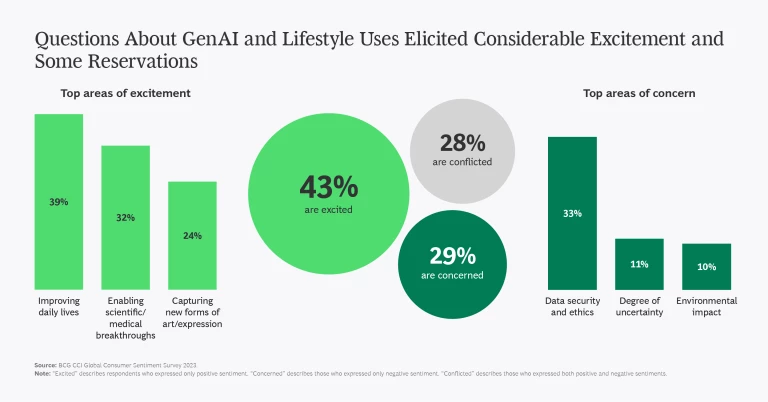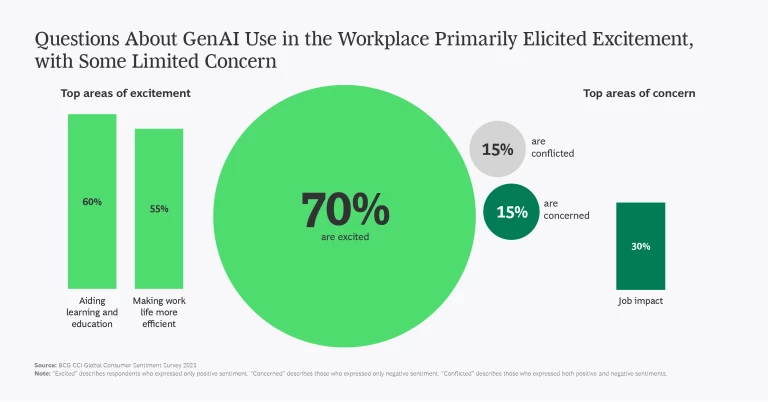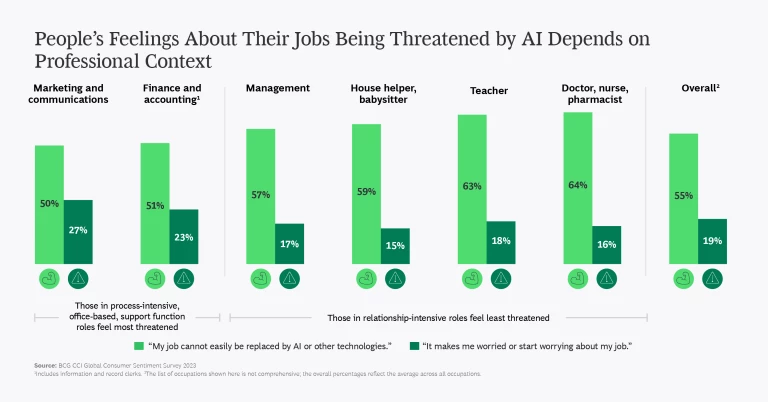
Aparna Bharadwaj and Jessica Apotheker
It took Spotify some 150 days to garner a million users. Instagram, about 75 days. ChatGPT? Just five days.
Artificial intelligence isn’t new, but broad public interest in it is, particularly as generative AI (GenAI) tools have been released over the past year. ChatGPT, for example, has become a household name. And our recent survey of consumers found that people are more knowledgeable and excited about AI than you might think. (See “About Our Research.”) Don’t underestimate them. Do understand them, deeply.
The facets of AI that excite consumers—and the ones that concern them—as they use AI-driven tools to shop, find information, do their jobs, and more are valuable guides to developing and deploying AI-enabled solutions and transformations.
About Our Research
BCG’s Center for Customer Insight surveyed 21,000 consumers from 21 countries, across continents:
| Argentina | Indonesia | South Korea |
| Australia | Japan | Sweden |
| Brazil | Mexico | Thailand |
| China | Morocco | Turkey |
| France | Philippines | UK |
| Germany | Saudi Arabia | United Arab Emirates |
| India | South Africa | US |
The survey was conducted from August through September 2023. It measured level of awareness of AI and GenAI, as well as usage and sentiment among consumers across markets. It also captured the reasons for positive and negative sentiment among consumers and explored questions relevant to use of AI in the workplace.
Many People Have Heard of AI—and Are Using It
Across the countries we surveyed, consumers’ awareness of AI is higher than expected. For example, more than 90% of consumers in India and the United Arab Emirates have heard of ChatGPT, and in China and Saudi Arabia awareness exceeds 80%. Respondents’ usage of ChatGPT is notable as well.
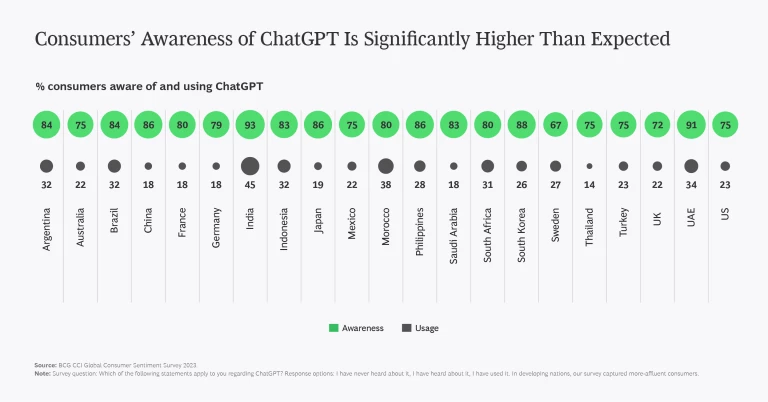
People are using other forms of AI, too, in a variety of ways to address unmet needs, and they recognize and appreciate the “three Cs” that AI delivers to them:
- Comfort, which improves personal well-being by helping with health, financial, and other goals. For example, 32% of survey respondents have used an AI-enabled health and fitness app.
- Customization, meaning assistance in finding the right product or service or meeting personal objectives. Among our respondents, 28% have turned to AI for personal recommendations for items, such as cosmetics.
- Convenience, to reduce friction and effort. The survey found that 28% of respondents have used AI-powered visual search to find products that match or resemble items they want to buy.
Overall, 75% of respondents to our survey have used ChatGPT or another AI-driven service. This number is surprisingly higher in markets such as India, Brazil, and the United Arab Emirates, where AI usage is leapfrogging the levels seen in so-called mature markets.
People Are Both Excited and Concerned About AI
Many consumers have some exposure to AI, but how do they feel about the technology?
Asking questions about that led us to an even more surprising finding: consumers demonstrate a highly nuanced understanding of AI and its positive and negative aspects. Consumers feel excited about AI—but a significant subset exhibit a good understanding of the potential downsides of AI if the technology is not “done right.”
While respondents reported, for the most part, that they are entirely excited about the various uses of AI, some feel conflicted—excited about some aspects but concerned about others.
We asked participants about AI’s effect on both lifestyle- and workplace-based issues. (See Slideshow.)
Consumers see the value the technology can bring, particularly to improve their daily lives, with 39% responding positively about AI’s influence on this factor. Excitement about AI in the workplace is high too: 60% see that AI will help with learning and education, and 55% anticipate workplace efficiencies. (For more results, see “Consumer Perspectives About AI in the Workplace.”)
Consumer Perspectives About AI in the Workplace
Those who feel most vulnerable are in marketing and communications as well as in finance and accounting, areas with jobs that tend to be process-intensive support roles that can perhaps be automated. At the other end of the spectrum are people in relationship-intensive roles; these individuals report feeling less threatened by AI.
People in high-demand professions also feel less threatened. Health care practitioners, counselors, and teachers are the least likely to feel that technology can replace them.
Because AI doesn’t affect all jobs equally, HR managers need to understand the real and perceived risks to specific job roles. It is up to them to manage employees’ sentiments and address their concerns. They can help employees understand where automation can augment rather than replace their role, and they can support upskilling that will enable employees to make use of AI technologies.
At the same time, respondents voiced some insightful concerns about AI. Thirty-three percent are worried about data security and ethical use of AI, and 30% are worried about the possibility of AI replacing workers in certain jobs. And as with lifestyle issues, a notable proportion have conflicted feelings about AI in the workplace.
All the above factors come together in an interesting phenomenon we call the “misinformation-excitement-concern” curve. Before using AI, consumers initially—and understandably—are worried about this new and unfamiliar world and are vulnerable to misinformation and myths about it. In addition, AI is a nascent technology, one that is especially confusing for those who are not digitally savvy.
Then, as consumers learn more about AI and interact with apps like ChatGPT or AI-enabled shopping recommendations, they get excited about the possibilities—the “three Cs” that AI promises. But the growing understanding that comes from greater experience quickly surfaces more thoughtful concerns, different from their original fears. Among them: Could we become too reliant on AI? Could my own job come to be at risk? Is my data going to be compromised?
It’s essential that marketers and leaders understand this curve when incorporating, developing, and deploying AI—to meet people “where they are,” foster excitement, and address concerns.
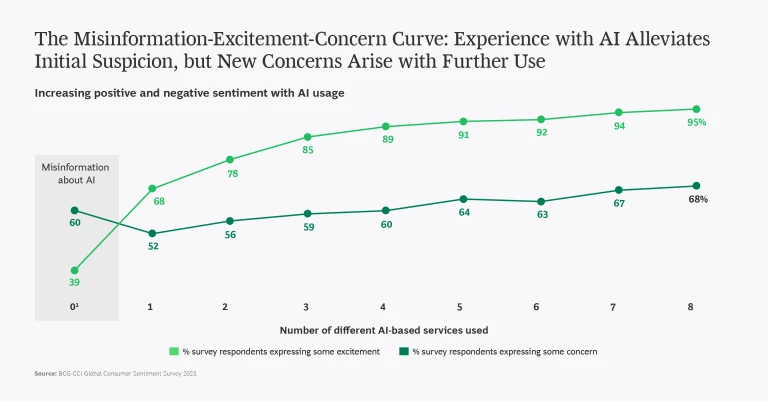
AI Sentiment Through a Country-by-Country Lens
Excited, concerned, and conflicted consumers of artificial intelligence exist in every country, of course. Those who are more excited are generally using AI more, having overcome their initial apprehension and become more aware of the positive outcomes. In the countries where excitement is higher, including China, India, Thailand, and the Philippines, consumers are using ChatGPT to find information, assist in research, and even as a personal assistant. By contrast, the number one reported use of ChatGPT in Australia, Germany, the UK, and the US is “just to play around” with it.
Countries with younger populations, which tend to have greater technical and digital experience, generally exhibit higher excitement. Concern is greater in countries where AI gets negative press coverage; in such environments, usage is lower, too.
The degree of digital competitiveness in a country influences consumer sentiment regarding AI. Concern is higher in some countries with digitally competitive economies—economies that feature access to knowledge and technology and a readiness for the future. Perhaps the threat to employees feels more real and imminent in these markets because businesses there now have the means to embed AI in their day-to-day operations. Conversely, in some less digitally competitive countries, excitement prevails. AI holds the promise to change and accelerate technological solutions to fundamental problems that are particularly prevalent in these countries, such as issues involving health care and education.
These trends converge to reveal that consumers in emerging markets are generally among those who are particularly open to and excited about AI. We hypothesize that this attitude could be connected to infrastructure and access limitations that AI could solve. In countries with a demand-supply mismatch, AI offers a chance to solve genuine unmet needs. For instance, patients who risk long waiting periods or significant travel to get medical attention may appreciate visiting with an AI-enabled virtual doctor more than consumers in markets where such demand-supply mismatches are less stark.
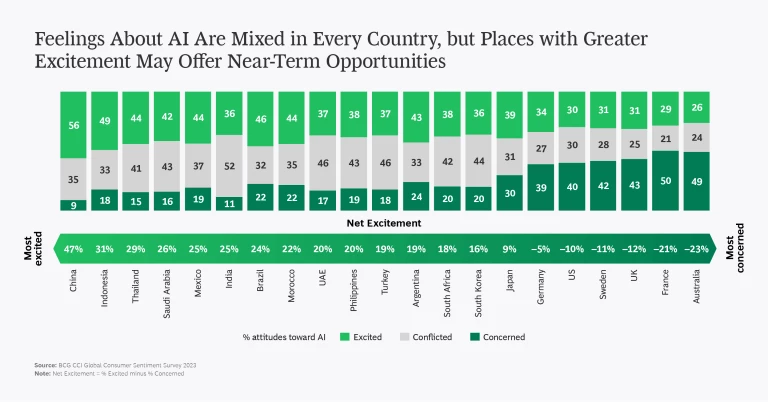
Lessons for Leaders
Build trust by respecting consumers’ views. Consumers have a solid understanding of AI; they see long-term implications—good and bad. Accordingly, the first step is to not underestimate their feelings about this transformative technology. Marketers and leaders must recognize consumers’ perspectives and be sure that their messages are neither overly optimistic nor dismissive of consumer concerns. Instead, they must operate and communicate honestly and objectively, balancing the benefits with explanations of the risks. In that way, they will build trust.
Brands tend to overpromise and underdeliver. That won’t satisfy this savvy audience. Rather, marketers and leaders should acknowledge unknowns and downsides as they roll out AI tools.
Navigate the misinformation-excitement-concern curve smartly. At the start of your organization’s journey with public-facing AI tools, counter misinformation and break myths to help bring people along.
Then, temper excitement and deploy AI using best practices, including responsible AI. Following responsible AI practices—which ensure that the technology is used ethically and responsibly—will help to reassure consumers and employees who are concerned about how hyperpersonalization can impact privacy, for example, and how data biases might be perpetuated as AI is trained. Companies can reinforce their commitment to responsible AI in their actions and communications.
As you scale the use of AI applications by your organization, continue to support consumers and employees and inspire trust. At the same time, put in place privacy protections and “just transition” measures that reassure and protect consumers and employees from the downsides of AI at scale.
Tap the pockets of excitement. Don’t assume emerging markets are lagging when it comes to AI. Consumers in these countries are among the respondents who are excited about the technology and likely to embrace it. Global deployments should mirror this trend rather than following the standard approach of debuting in mature markets. Why not launch AI products and features where the uptake promises to be particularly wide and swift?
Emerging markets are appealing for other reasons, too. They have larger populations, meaning more customers and more data to drive solutions. They have cost-efficient infrastructures and government support as well as prevailing laws and regulations that will enable deployments. And AI models, which can be expensive and energy intensive, could be more cost-efficient in emerging markets.
Consumers are more knowledgeable about AI than we imagined, with a more nuanced understanding than they are given credit for. This perception varies by markets, by the kind of exposure consumers have to AI applications, and by the thought of how AI could change their lives and livelihoods. It’s critical for leaders to keep this understanding in mind at all times if they want to deploy AI successfully and at scale.

